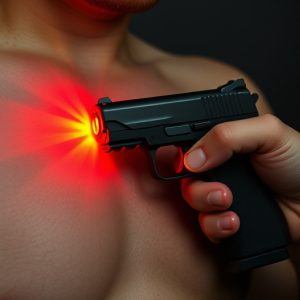Guide to Choosing the Best Stun Gun: Mechanisms, Effectiveness, and Legal Use
Stun guns are non-lethal self-defense devices that emit electrical charges for incapacitating attac…….
Stun guns are non-lethal self-defense devices that emit electrical charges for incapacitating attackers. They typically require direct contact with the target's skin to be effective, although advanced models may offer drive stun capabilities allowing for use even without skin contact. The devices work by causing neuromuscular involuntary contractions through an electrical current passed through muscle tissue. Safe and responsible use is paramount and demands adherence to manufacturer guidelines, proper training, and awareness of local laws regulating stun gun possession and use. Effectiveness also depends on factors like the intensity of the shock, device design, including LED lights and flashlights for visibility, and user proficiency in handling the stun gun during confrontations. When considering a stun gun for personal safety, it's crucial to evaluate its voltage and amperage, as these determine its efficacy. High-voltage models are often favored by users for their ability to potentially work without skin contact, especially with drive stun features. Additionally, build quality, safety features like accident prevention switches, and extra functions such as a built-in flashlight are key considerations. Users should consult user reviews to find a stun gun that fits their needs for effective self-defense while ensuring compliance with the law in their jurisdiction.
When considering personal safety devices, stun guns emerge as a potent option. This article delves into the mechanics of stun guns, shedding light on how they operate and the importance of handling them with care. We explore the effectiveness of these self-defense tools, examining factors that influence their performance. Legal nuances surrounding stun gun use are also clarified to ensure users remain informed and compliant. A key aspect we examine is whether a stun gun needs direct contact with the skin for effectiveness—a critical detail for many potential users. Additionally, we guide readers through the myriad of stun guns available, providing insightful reviews and recommendations to aid in selecting the most suitable model for individual defense needs.
Understanding Stun Guns: Mechanisms and Safety Considerations
When considering personal safety devices, stun guns stand out as a non-lethal option for deterrence and defense. These electronic devices emit a high-voltage, low-ampersonal electrical charge designed to incapacitate an attacker. A common question regarding their use is whether the stun gun has to physically touch the skin of the target to be effective. Typically, stun guns require direct contact with the assailant’s body to deliver the electrical shock; however, certain models incorporate drive stun capabilities that can incapacitate an individual even without a direct hit. Understanding the mechanics behind these devices is crucial for responsible ownership and use. The current passes through the muscle tissue, causing neuromuscular involuntary contraction which temporarily immobilizes the individual. Safety considerations are paramount when handling stun guns; it’s important to adhere to manufacturer guidelines to prevent accidental discharge or misuse. Proper training is also essential to ensure that the device is used effectively and only in situations where personal safety is at risk. Additionally, users should be aware of local laws and regulations governing the possession and use of stun guns, as these can vary by jurisdiction. Regular maintenance and understanding the limitations and proper application of the stun gun are integral to its safe and effective operation.
Effectiveness of Stun Guns: Factors Influencing Their Efficacy
Stun guns are often cited as a non-lethal self-defense tool, but their effectiveness can be influenced by several factors. One critical aspect to consider is physical contact; the stun gun must make contact with the assailant’s skin to deliver an electric shock effectively. This direct contact is essential for the conductive prongs to fully transmit the electrical current, which induces neuromuscular incapacitation. The intensity of the shock, measured in microcoulombs, is another determinant of a stun gun’s efficacy. Higher microcoulomb levels can lead to more potent muscle contractions and a higher likelihood of incapacitating an attacker.
Furthermore, the design and build quality of the stun gun play a significant role in its performance. Features such as LED lights to distract attackers, a bright flashlight for low-light conditions, and a strong, durable battery are all factors that can affect the reliability of the device. Additionally, the size and shape of the stun gun can impact user comfort and handling during a confrontation. It’s also worth mentioning that user training and confidence with the device are crucial components of its effectiveness. Understanding how to deploy a stun gun properly, including aiming and maintaining contact until the assailant is incapacitated, is as important as the technical specifications of the weapon itself.
Legal Implications of Using a Stun Gun: What You Need to Know
When considering the use of a stun gun for self-defense, understanding the legal implications is paramount. In many jurisdictions, laws governing the possession and use of stun guns are stringent and vary widely. It’s crucial to verify local regulations as some areas may prohibit their ownership or impose strict conditions on their use. One frequently asked question regarding stun gun effectiveness is whether it needs to physically touch the skin to be effective. Generally, for a stun gun to deliver its electric shock effectively, it should make contact with an individual. However, the level of voltage and amperage can influence the distance at which the device can incapacitate a target. Users must exercise caution and adhere to the manufacturer’s guidelines to avoid accidental misuse or injury. Additionally, the use of a stun gun in self-defense is subject to legal scrutiny similar to any other weapon; therefore, users should be aware that the circumstances of each case will be evaluated based on local laws and standards for justifiable use of force. Understanding these legal considerations ensures responsible ownership and use, which is essential for maintaining one’s safety and compliance with the law.
The Role of Contact in Stun Gun Efficiency: Does It Have to Touch Skin?
When assessing the effectiveness of a stun gun, one critical factor is the role of contact with the target. Traditionally, stun guns have been designed to deliver an electrical shock that must pass through the skin to effectively incapacitate an attacker. The efficacy of a stun gun hinges on this physical interaction; it typically requires direct skin contact to transmit the electric current required for neutralizing an aggressor. This is because the intensity and pattern of the electrical discharge are contingent upon the conductive properties of the skin. Without touching the skin, the electrical charge may dissipate into the environment or be inadequate to elicit the muscle contractions that render an assailant immobile.
However, advancements in stun gun technology have led to variations in design and function. Some modern stun guns incorporate features like driven electrodes that can penetrate thick clothing or even make contact with less resistance, broadening their range of effectiveness beyond the immediate skin contact requirement. These improvements are pivotal as they enhance the safety and utility of stun guns for users who may face attackers wearing multiple layers or who might be at a slight distance. Despite these technological strides, it’s crucial to understand the limitations and proper usage of these devices within legal guidelines and self-defense scenarios. Users should familiarize themselves with the specifications and capabilities of their chosen stun gun model to ensure they can rely on its performance when facing an aggressive situation.
Selecting the Right Stun Gun: Features and Recommendations Based on User Reviews
When considering the purchase of a stun gun for personal safety, it’s crucial to evaluate various factors based on user reviews and product specifications. A key aspect to consider is the voltage and amperage, as these determine the device’s effectiveness in incapacitating an assailant. User feedback often highlights the importance of a high-voltage stun gun for its neutralizing capabilities. Additionally, the stun gun’s design should ensure that it delivers an electric shock without having to directly touch the skin. This feature can be particularly important in self-defense scenarios where direct contact might not be possible or advisable. The distance capability of a stun gun, often referred to as drive stun feature, allows users to maintain a safe distance while still being able to deploy the device effectively.
Another significant factor is the stun gun’s build quality and safety features. A durable and reliable stun gun should be made with high-quality materials to ensure longevity and effectiveness in various conditions. Features such as a flashlight, which can temporarily blind an attacker and assist in aiming at night, are highly recommended based on user experiences. Moreover, additional safety features like a safety switch that prevents accidental discharges can provide peace of mind. It’s also advisable to look for stun guns with a non-lethal cartridge option, as some models offer this feature for situations where the electric shock alone might not be enough to deter an attacker. Reading through user reviews can guide potential buyers in selecting a stun gun that best suits their needs and circumstances, ensuring they are prepared in the event of an encounter with an aggressor.


